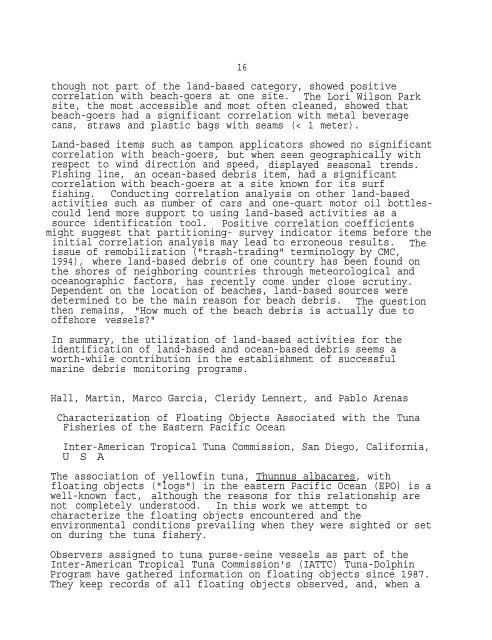Poster abstracts and manuscripts from the Third International ...
Poster abstracts and manuscripts from the Third International ...
Poster abstracts and manuscripts from the Third International ...
Create successful ePaper yourself
Turn your PDF publications into a flip-book with our unique Google optimized e-Paper software.
16<br />
though not part of <strong>the</strong> l<strong>and</strong>-based category, showed positive<br />
correlation with beach-goers at one site. The Lori Wilson Park<br />
site, <strong>the</strong> most accessible <strong>and</strong> most often cleaned, showed that<br />
beach-goers had a significant correlation with metal beverage<br />
cans, straws <strong>and</strong> plastic bags with seams (< 1 meter).<br />
L<strong>and</strong>-based items such as tampon applicators showed no significant<br />
correlation with beach-goers, but when seen geographically with<br />
respect to wind direction <strong>and</strong> speed, displayed seasonal trends.<br />
Fishing line, an ocean-based debris item, had a significant<br />
correlation with beach-goers at a site known for its surf<br />
fishing. Conducting correlation analysis on o<strong>the</strong>r l<strong>and</strong>-based<br />
activities such as number of cars <strong>and</strong> one-quart motor oil bottlescould<br />
lend more support to using l<strong>and</strong>-based activities as a<br />
source identification tool. Positive correlation coefficients<br />
might suggest that partitioning- survey indicator items before <strong>the</strong><br />
initial correlation analysis may lead to erroneous results. The<br />
issue of remobilization ("trash-trading" terminology by CMC,<br />
1994), where l<strong>and</strong>-based debris of one country has been found on<br />
<strong>the</strong> shores of neighboring countries through meteorological <strong>and</strong><br />
oceanographic factors, has recently come under close scrutiny.<br />
Dependent on <strong>the</strong> location of beaches, l<strong>and</strong>-based sources were<br />
determined to be <strong>the</strong> main reason for beach debris. The question<br />
<strong>the</strong>n remains, "How much of <strong>the</strong> beach debris is actually due to<br />
offshore vessels?"<br />
In summary, <strong>the</strong> utilization of l<strong>and</strong>-based activities for <strong>the</strong><br />
identification of l<strong>and</strong>-based <strong>and</strong> ocean-based debris seems a<br />
worth-while contribution in <strong>the</strong> establishment of successful<br />
marine debris monitoring programs.<br />
Hall, Martin, Marco Garcia, Cleridy Lennert, <strong>and</strong> Pablo Arenas<br />
Characterization of Floating Objects Associated with <strong>the</strong> Tuna<br />
Fisheries of <strong>the</strong> Eastern Pacific Ocean<br />
Inter-American Tropical Tuna Commission, San Diego, California,<br />
USA<br />
The association of yellowfin tuna, Thunnus albacares, with<br />
floating objects ("logs") in <strong>the</strong> eastern Pacific Ocean (EPO) is a<br />
well-known fact, although <strong>the</strong> reasons for this relationship are<br />
not completely understood. In this work we attempt to<br />
characterize <strong>the</strong> floating objects encountered <strong>and</strong> <strong>the</strong><br />
environmental conditions prevailing when <strong>the</strong>y were sighted or set<br />
on during <strong>the</strong> tuna fishery.<br />
Observers assigned to tuna purse-seine vessels as part of <strong>the</strong><br />
Inter-American Tropical Tuna Commission's (IATTC) Tuna-Dolphin<br />
Program have ga<strong>the</strong>red information on floating objects since 1987.<br />
They keep records of all floating objects observed, <strong>and</strong>, when a
















